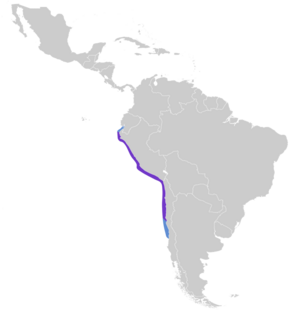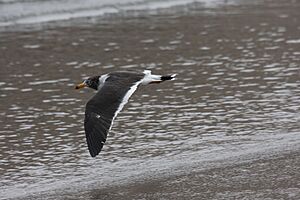Belcher's gull facts for kids
Quick facts for kids Belcher's gull |
|
|---|---|
 |
|
| Conservation status | |
| Scientific classification | |
| Genus: |
Larus
|
| Species: |
belcheri
|
 |
|
The Belcher's gull (Larus belcheri) is a cool bird. It's also known as the band-tailed gull. This type of gull lives along the Pacific coast of South America.
It used to be thought that the very similar Olrog's gull was the same species. But Olrog's gull lives on the Atlantic coast. Now, scientists know they are different birds.
Belcher's gull is a medium-sized bird. It has a blackish back and white head. Its belly is also white. A wide black band crosses its white tail. The bill is yellow with a red and black tip. When not breeding, its head turns brownish-black. It also has a white ring around its eye. This bird is named after Sir Edward Belcher, a British explorer. He studied the Pacific coast of South America.
Contents
What Does Belcher's Gull Look Like?
Belcher's gull grows to be about 49 centimeters (19 inches) long. Male and female gulls look very similar. During the breeding season, adults have a white head. Their neck and belly are a very light gray. The back and upper parts are grayish-black.
The tail is white with a wide black band near the end. It also has a white edge. Its wing feathers are black. The eyes are black. The bill is yellow with a special red and black tip. Its legs and feet are yellow.
When it's not breeding, the gull's head turns dark brown. It still has a white ring around its eye. Young gulls are mottled brown and white. They get their adult colors when they are about three years old.
You might confuse Belcher's gull with the kelp gull. The kelp gull is a bit bigger. But the kelp gull has a small white tip on its black wing. It also does not have the black tail band. This band is a key feature of Belcher's gull.
Where Does Belcher's Gull Live?
Belcher's gull lives on the Pacific coast of South America. Its home stretches from northern Peru to northern Chile. This area is affected by the Humboldt Current. It lives on rocky shores, in bays, and on islands offshore.
This gull flies several kilometers out to sea to find food. It also searches for food on rocky shores when the tide is low. Belcher's gull does not migrate. This means it stays in the same area all year.
How Does Belcher's Gull Find Food?
Belcher's gull is an omnivore. This means it eats both plants and animals. It is also a scavenger. This means it eats dead animals or leftover food. It eats fish, crabs, and mollusks. It also eats dead animals it finds.
Sometimes, it eats the eggs and young birds of other seabirds. Belcher's gulls often hang around Guanay cormorants. They bother the cormorants until they throw up their food. Then, the gull eats it!
How Does Belcher's Gull Raise Its Young?
Belcher's gulls start breeding in December. They nest in small groups. These groups can have up to one hundred pairs of gulls. The nest is a simple scrape in the sand. Or it might be among rocks near the high tide line.
They usually lay three eggs. The eggs are about 65 by 45 millimeters (2.6 by 1.8 inches). They are pale with dark olive spots.
Is Belcher's Gull in Danger?
Scientists believe there are fewer than ten thousand Belcher's gulls in total. Their home range is about 280,000 square kilometers (108,000 square miles). People used to hunt these birds. But now, fewer people bother them.
Because of this, their numbers seem to be growing. Even though there aren't many of them and they live in a small area, the International Union for Conservation of Nature says they are of "least concern". This means they are not currently in danger of disappearing.




